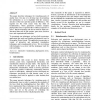Free Online Productivity Tools
i2Speak
i2Symbol
i2OCR
iTex2Img
iWeb2Print
iWeb2Shot
i2Type
iPdf2Split
iPdf2Merge
i2Bopomofo
i2Arabic
i2Style
i2Image
i2PDF
iLatex2Rtf
Sci2ools
AUIC
2006
IEEE
2006
IEEE
Visualising phylogenetic trees
• This paper describes techniques for visualising pairs of similar trees. Our aim is to develop ways of presenting the information so as to highlight both the common structure of the trees and their points of difference. The impetus for the work comes from the field of bioinformatics, where geneticists construct complex phylogenetic trees to represent the evolution of species or genes. But the techniques can also be used for other treestructured data such as file systems, parse trees, decision trees, and organisational hierarchies. To investigate our techniques, we have built a prototype application that reads and displays phylogenetic trees in the popular Nexus format. The application incorporates a variety of interactive and automated visualisation techniques, and is implemented in Java. We are working with biologists to see how well the techniques work for real-world data.
AUIC 2006 | Complex Phylogenetic Trees | Paper Describes Techniques | Phylogenetic Trees | Software Engineering |
| Added | 10 Jun 2010 |
| Updated | 10 Jun 2010 |
| Type | Conference |
| Year | 2006 |
| Where | AUIC |
| Authors | Wan Nazmee Wan Zainon, Paul R. Calder |
Comments (0)

